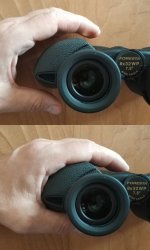Rob, yes I think you are absolutelly missing out on something great

I'm a lover of porros, and I think even in 2020 they offer so much both in terms of pure performance but also in more subtle areas, such as plasticity of the image.
Some days ago I was testing two very good 8x32 roofs, Leica Ultravid HD and Zeiss FL. Both have been the top models of their brands until not that long ago, with a retail price in excess of 1500 €/$. The view was really nice through either of those. Buth then I added the Nikon E2 8x30 into the mix. An eye-opener. None of the top roofs could match the 3D view, the plasticity and sense of "being there" that the little porro offered at 1/4 of the price. I guess that's one very good reason to at leas take them into account.
Then there's the shape/fit/grip factor. I completely agree with Joachim: for me some porros have the best "grip" of any binoculars I've tried. The Nikon SE just merge in your hands to the point that they seem to disappear, to become one with your hand (which I think is the ultimate goal of a binocular; just like a translator or an interpreter, the great ones make you forget they're there). These days I'm using (with great joy!) a quite inexpensive porro, the 8x32 Foresta, and the grip is just mind-blowing. I know some people like open hinge design while others prefer narrow bridge and a lot of space on the tubes. I think my favourite grip is a porro with tapered "shoulders". Have a look at the picture. My hand in a "natural" position... and then the Foresta fits in like a tailored glove, with index and middle finger resting effortlessly on the focus wheel. But even classic porros like the Habicht have a sensational grip; the "lobed" shape of the tubes (not straight) in classical porros makes for a more "organic grip" (if you know what I mean).
And on pure optical performance, I'm sure there's a lot of well informed forum members here to talk you about the technicalities, but there are still some porros among the top performers. Take the Fujinon FMT (yes, I know it is not a "birders bino", but I think it serves to illustrate the point), its performance is just stunning. Or the small and humble-looking Habicht; a wolf in sheeps skin. If I had endless resources, I'd have a Habicht just for the sheer pleasure of looking through it: such a bright, sharp and sensational view. If you like binoculars, I think you should at least try some of those once. There are great roof binoculars (most current top-nocht binoculars) as there are Abbe-König (FL, WX)... but there also great performing porros, both in the top-end and the lower step of the ladder (take the Kowa YF, Leupold Yosemite).
As for close-focusing problems. Well, yes, most roofs will focus closer than classic porros. But if you want the ultimate macro view, well, then it's porros again, Pentax Papilio

(yes, I know it's a reverse porro, but makes the point). As Arthur says, most of what we do is watch birds that are far away (mind you, I love watching lizards and bugs, and I do appreciate a good close focus).
To quote Holger Merlitz:
don't dismiss the porros 







